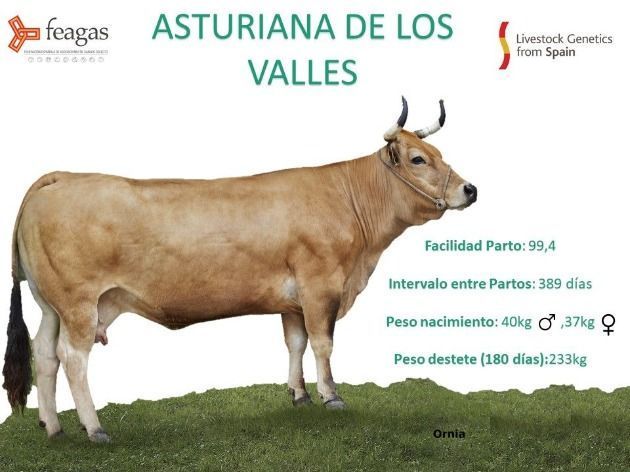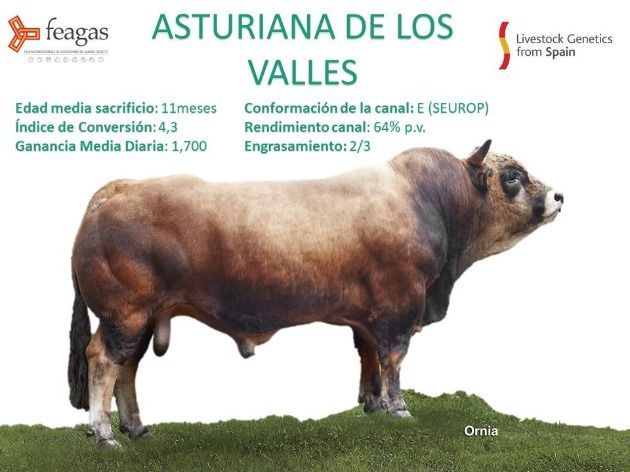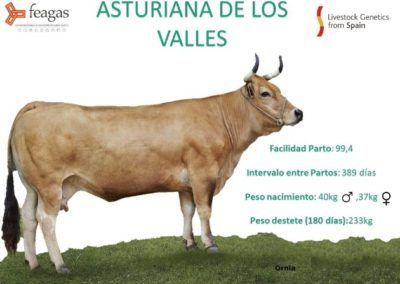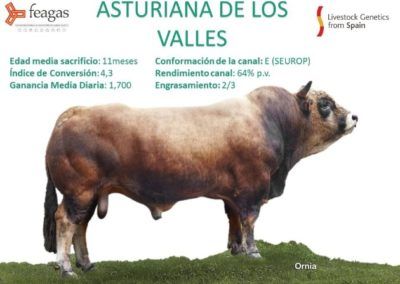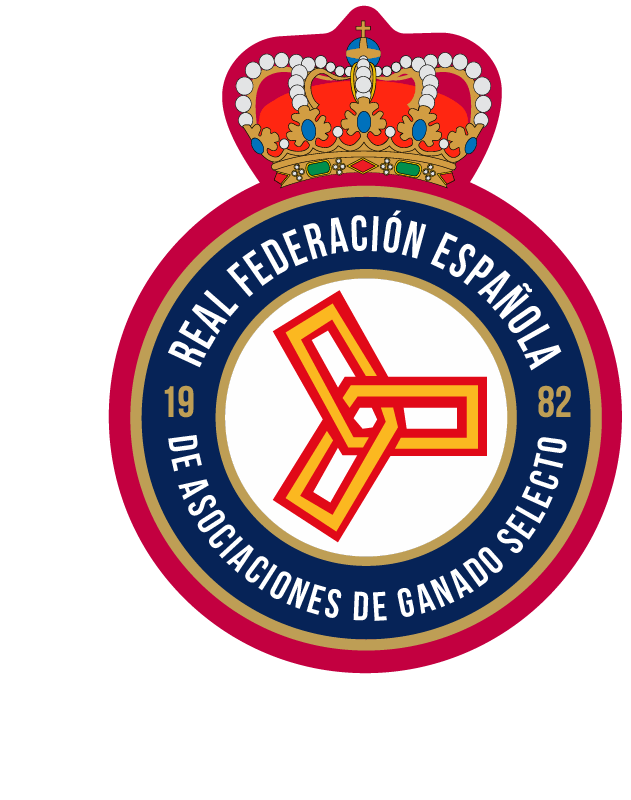GENERAL CHARACTERISTICS
They have a straight or slightly subconvex profile and a balanced appearance. Depending on their muscular development, they are classified into two types of conformation: big bottomed and normal fitness.
The colouring of the coat is chestnut, varying from straw yellow to reddish brown, with creamy degradations on the rim of the muzzle, inside of the limbs and on the forelegs. The buccolingual and anovulvar mucous membranes are black. In addition, the animals of this breed have a black tail feathering, horns yellowish white at the base and black at the tip, and ears with light hairs on the inside and dark hairs on the edge.
PRODUCTION CHARACTERISTICS AND EXPLOITATION SYSTEMS
The reproductive characteristics of the females of this breed include a 92 % calving rate without difficulty with a calving interval of 380 days, and an age at first calving of 31 months. Calves are born with an average weight of 40 kg and reach a growth rate of 942 g/day during lactation.
Bulls of the Asturiana de los Valles’s breed are widely used in industrial crossbreeding with Friesian cows and other breeding cows, both in natural mating and through artificial insemination. The crossbred calf is born without difficulty and very well conformed, as the Asturian bulls provide the product with muscularity and an increase in the sensory quality of the meat.
As a mark of quality, the breed has the ‘Xata Roxa’ brand, which is part of the ‘Ternera Asturiana’ Protected Geographical Indication. The typical products are Veal, slaughtered at less than 12 months, and Yearling, slaughtered at between 12 and 18 months.
GEOGRAPHICAL DISTRIBUTION
The geographical distribution of the Asturiana de los Valles’s breed is quite wide, with a presence in twelve Spanish Autonomous Communities, with the largest populations in the communities of the Cantabrian Coast, Castilla-Leon, and Extremadura.
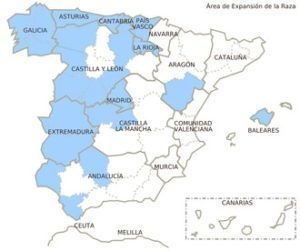
At Livestock Genetics from Spainwe have visited the facilities of Asturgen, the official insemination centre for the Asturiana de los vallesbreed, with the aim of disseminating and promoting the genetics of purebred Spanish breeds.
Abel García González, Sales Director of Asturgen, explained the need for Asturian breeders to improve the genetics of their herds. He also listed the excellent characteristics of the Asturiana de los Valles:
- Hardiness
- Precocity
- Tenderness
The Asturiana de los Valles stands out not only for its interest in Spain, but also abroad, as it is perfect for crossbreeding.
INFORMACIÓN
 Tell us about your characteristics and needs so that we can offer you the solution that best suits your context. Contact us if you have any clarifications or suggestions for products or services that you need.
Tell us about your characteristics and needs so that we can offer you the solution that best suits your context. Contact us if you have any clarifications or suggestions for products or services that you need.
Presupuesto total: 543.404,60 euros. Cofinanciado UE al 80% por el Fondo Europeo Agrícola de Desarrollo Rural- FEADER y al 20% por el MAPA. La Dirección General de Desarrollo Rural, Innovación y Formación Agroalimetnaria (DGDRIFA) es la autoridad de gestión encargada de la aplicación de la ayuda FEADER y nacional correspondiente.
https://ec.europa.eu/info/eu-
Creación de una base y estructura de comercialización e internacionalización de material genético de razas puras españolas mediante análisis de la situación actual y elaboración de plan estratégico para la exportación. El objetivo es desarrollar un análisis estratégico de la internacionalización y desarrollo de estructura y protocolos de comercialización del material genético según demanda y requisitos de países objetivos para las razas participantes del proyecto y para el conjunto de la cabaña ganadera España. Organismo responsable de contenido: miembros del GO EXPORTGEN.
 Livestock Genetics from Spain (LGFS) es una plataforma para dar visibilidad al Grupo Operativo (G.O) ExportGen, integrado por FEAGAS como miembro ejecutor, así como los miembros asociados ASEAVA (Asociación de Asturiana de los Valles), ACRUGA (Asociación de Rubia Gallega) y ANCCE (Asociación del Caballo Pura Raza Español). El objetivo es dar a conocer estas 3 razas fuera de España.
Livestock Genetics from Spain (LGFS) es una plataforma para dar visibilidad al Grupo Operativo (G.O) ExportGen, integrado por FEAGAS como miembro ejecutor, así como los miembros asociados ASEAVA (Asociación de Asturiana de los Valles), ACRUGA (Asociación de Rubia Gallega) y ANCCE (Asociación del Caballo Pura Raza Español). El objetivo es dar a conocer estas 3 razas fuera de España.
Presupuesto total: 543.404,60 euros. Cofinanciado UE al 80% por el Fondo Europeo Agrícola de Desarrollo Rural- FEADER y al 20% por el MAPA. La Dirección General de Desarrollo Rural, Innovación y Formación Agroalimetnaria (DGDRIFA) es la autoridad de gestión encargada de la aplicación de la ayuda FEADER y nacional correspondiente.
https://ec.europa.eu/info/eu-
Creación de una base y estructura de comercialización e internacionalización de material genético de razas puras españolas mediante análisis de la situación actual y elaboración de plan estratégico para la exportación. El objetivo es desarrollar un análisis estratégico de la internacionalización y desarrollo de estructura y protocolos de comercialización del material genético según demanda y requisitos de países objetivos para las razas participantes del proyecto y para el conjunto de la cabaña ganadera España. Organismo responsable de contenido: miembros del GO EXPORTGEN.

